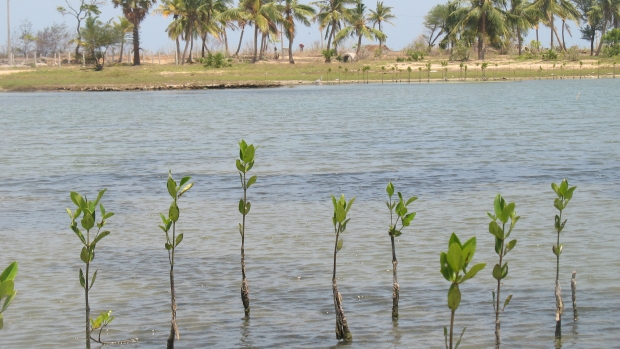Grants :: Small Grant Facilities :: Replanting mangroves in Batticaloa lagoon
Replanting mangroves in Batticaloa lagoon

Rmucronata Batticaloa, Sri Lanka © KEkaratne, 2009
Objectives
The objectives of this project were twofold: to create awareness among local communities of the importance of Batticaloa lagoon and its flora and fauna to their daily lives; and to mobilise the communities to protect the lagoon environment effectively.
Background
Batticaloa lagoon is both an important ecological resource, providing habitats for many resident and migratory bird species, and an important economic resource, supporting the livelihoods of over 4,000 fishermen.
In recent years, however, the lagoon has seen heavy loss of the mangroves along its eastern shore. Development and the civil conflict have led to the clearing of 90% of these mangroves, reportedly causing a decline in fish and prawn sizes and catches. Local communities also complain of reduced firewood and timber supplies, and fewer reptiles and birds.
It is vital, therefore, to raise awareness of the importance of the remaining mangroves at Batticaloa and the fauna and flora that depend on them.
Target beneficiaries
Fishermen living around Batticaloa lagoon.
Outputs
- Awareness raised on the importance of mangroves and their associated fauna and flora.
- Identification of six locations for planting mangroves.
- Propagation of 17,000 seedlings in a nursery.
- Establishment of 180 mangrove enclosures.
- Planting of 17,000 mangrove seedlings.
Accomplishments and challenges
Fishermen have come to appreciate the importance of mangroves through project activities. Project participants helped to collect seeds from different mangrove species and propagate them in a nursery. They then replanted the seedlings in the lagoon in the hope that the resulting vegetation cover would help to restore the natural fishery and eventually improve fishermen’s returns.
Seedlings of Rhizophora mucronata, Excoecaria agallocha, Sonneratia alba, Bruguiera gymnorrhiza, Lumnitzera racemosa, Avicennia marina, Hibiscus sp. and Cerbera manghas were planted by the project.
Four of the six planting sites have seen a considerable increase in mangrove tree cover; the grantee, MANDRU, is pursuing further work at the other two sites.
Challenges:
The planting encountered several problems due to changing weather conditions, including fluctuating water quality, retardation of root development by heavy rain, difficulties in planting during the dry season, and a fungal infection that affected every tree during the dry season. Further, young mangrove plants were browsed by stray cattle and goats, and some species did not survive replanting.
These problems and the work required initially made fishermen reluctant to support the project. It was only after repeated discussions that they came to realise the importance of mangroves and agreed to maintain the planting sites.
Contributions to cross-cutting themes
It is expected that replanted mangroves will increase the green cover in the area and thereby assist in mitigating climate change related effects to a certain extent.
Lessons Learned
The mangrove species used in planting should be sourced locally; other species unadjusted to local conditions may not be as successful and may also have a negative impact on the environment. The progress of planting and growing should also be regularly monitored.
With enough time and awareness-raising efforts, local beneficiaries can be encouraged to look after planting sites. Schoolchildren have been identified as being most receptive to awareness-raising activities.
Project Facts
Country
Location
Batticaloa, Sri Lanka
Topic
Duration
1st Jan 2009 to 31st Dec 2009
MFF Grant Amount
US$4,360
Implementing Partner
MANDRU (Institute for Alternative
Development and Regional Cooperation)
19 Saravana Road, Kallady,
Batticaloa, Sri Lanka
